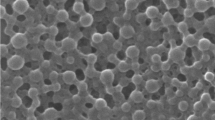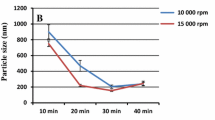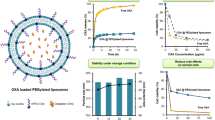Abstract
Liposomes have been widely investigated as drug carriers for a broad range of anticancer drugs. However, their application as a drug delivery system may be challenging due to low encapsulation of active ingredient and poor stability which leads to uncontrolled delivery of bioactive ingredients. The present study aims at incorporating 1,2-dioleoyl-sn-glycero-3-phosphoethanolamide-N-[methoxy(polyethylene glycol)-2000 (DOPEPEG2000) into oleic acid (OA) liposomes in order to prolong the lifetime in blood circulation. The pH transition curve of oleic was obtained by titration of sodium oleate solution with 0.05 mol dm−3 HCl to determine the region where liposomes were abundantly present. The critical vesicle concentration (CVC) was then determined by surface tension measurements. Dry lipid liposomes were hydrated with phosphate buffer at just over twice the CVC value. Optical polarizing microscopy (OPM) showed the presence of liposomes while transmission electron microscopy (TEM) confirmed that the liposomes prepared were spherical in shape and less than 200 nm in size. The incorporation of DOPEPEG2000 into the oleic acid liposomes reduced the average particle size and zeta potential to mimic the red blood cells. The encapsulation efficiency of various anticancer drugs was more than 60% while more than 20% of the drugs were released after 24 h. The results suggest that DOPEPEG2000: oleic acid at a molar ratio of 1:50 fulfilled the requirements for intravenous drug delivery.







Similar content being viewed by others
References
Gulati M, Grover M, Singh S, Singh M. Lipophilic drug derivatives in liposomes. Int J Pharm. 1998;165:129–68.
Naeem S, Kiew LV, Chung LY, Suk VRE, Mahmood A, Misran MB. Optimization of phospholipid nanoparticle formulations using response surface methodology. J Surfactants Deterg. 2016;19:67–74.
Teo YY, Misran M, Low KH, Zain SM. Effect of unsaturation on the stability of C18 polyunsaturated fatty acids vesicles suspension in aqueous solution. Bull Korean Chem Soc. 2011;32:59–64.
Gebicki JM, Hicks M. Ufasomes are stable particles surrounded by unsaturated fatty acid membranes. Nature. 1973;243:232–4.
Morigaki K, Walde P. Fatty acid vesicles. Curr Opin Colloid Interface Sci. 2007;12:75–80.
Mufamadi MS, Pillay V, Choonara YE, Du Toit LC, Modi G, Naidoo D, Ndesendo VM. A review on composite liposomal technologies for specialized drug delivery. J Drug Deliv. 2011;2011:939851.
Lehtinen J, Magarkar A, Stepniewski M, Hakola S, Bergman M, Róg T, Yliperttula M, Urtti A, Bunker A. Analysis of cause of failure of new targeting peptide in PEGylated liposome: molecular modeling as rational design tool for nanomedicine. Eur J Pharm Sci. 2012;46:121–30.
Hsu W-H, Liu S-Y, Chang Y-J, Chang C-H, Ting G, Lee T-W. The PEGylated liposomal doxorubicin improves the delivery and therapeutic efficiency of 188Re-Liposome by modulating phagocytosis in C26 murine colon carcinoma tumor model. Nucl Med Biol. 2014;41:765–71.
Lewinski NA, McInnes BT. Using natural language processing techniques to inform research on nanotechnology. Beilstein J Nanotechnol. 2015;6:1439–49.
Menon P, Yin Yin T, Misran M. Preparation and characterization of liposomes coated with DEAE-Dextran. Colloids Surf A. 2015;481:345–50.
McClements DJ (1998) Food emulsions: principles, practice, and techniques. Taylor & Francis.
Sahu A, Choudhury S, Bera A, Kar S, Kumar S, Mandal A. Anionic-nonionic mixed surfactant systems: micellar interaction and thermodynamic behavior. J Dispersion Sci Technol. 2015;36:1156–69.
Ohnishi N, Yamamoto E, Tomida H, Hyodo K, Ishihara H, Kikuchi H, Tahara K, Takeuchi H. Rapid determination of the encapsulation efficiency of a liposome formulation using column-switching HPLC. Int J Pharm. 2013;441:67–74.
Chen IA, Szostak JW. A kinetic study of the growth of fatty acid vesicles. Biophys J. 2004;87:988–98.
Kanicky JR, Shah DO. Effect of degree, type, and position of unsaturation on the pKa of long-chain fatty acids. J Colloid Interface Sci. 2002;256:201–7.
Shankar BV, Patnaik A. pH-dependent chiral vesicles from enantiomeric sodium 2,3-Bis(decyloxy) succinate in aqueous solution. Langmuir ACS J Surf Colloids. 2007;23:3523–9.
Tan HW, Misran M. Polysaccharide-anchored fatty acid liposome. Int J Pharm. 2013;441:414–23.
Bera A, Mandal A. Microemulsions: a novel approach to enhanced oil recovery: a review. J Pet Explor Prod Technol. 2015;5:255–68.
Chia SW, Misran M. flow behavior of oleic acid liposomes in sucrose ester glycolipid oil-in-water emulsions. J Surfactants Deterg. 2013;17:1–10.
Ciani L, Ristori S, Bonechi C, Rossi C, Martini G. Effect of the preparation procedure on the structural properties of oligonucleotide/cationic liposome complexes (lipoplexes) studied by electron spin resonance and Zeta potential. Biophys Chem. 2007;131:80–7.
Levchenko TS, Rammohan R, Lukyanov AN, Whiteman KR, Torchilin VP. Liposome clearance in mice: the effect of a separate and combined presence of surface charge and polymer coating. Int J Pharm. 2002;240:95–102.
Zhang T, Li Y, Mueller A. Phase structure of liposome in lipid mixtures. Chem Phys Lipids. 2011;164:722–6.
Bera A, Kumar S, Mandal A. Temperature-dependent phase behavior, particle size, and conductivity of middle-phase microemulsions stabilized by ethoxylated nonionic surfactants. J Chem Eng Data. 2012;57:3617–23.
Matyszewska D. Comparison of the interactions of daunorubicin in a free form and attached to single-walled carbon nanotubes with model lipid membranes. Beilstein J Nanotechnol. 2016;7:524–32.
Eloy JO, Claro de Souza M, Petrilli R, Barcellos JPA, Lee RJ, Marchetti JM. Liposomes as carriers of hydrophilic small molecule drugs: strategies to enhance encapsulation and delivery. Colloids Surf B. 2014;123:345–63.
Gillet A, Grammenos A, Compère P, Evrard B, Piel G. Development of a new topical system: drug-in-cyclodextrin-in-deformable liposome. Int J Pharm. 2009;380:174–80.
Dash S, Murthy PN, Nath L, Chowdhury P. Kinetic modeling on drug release from controlled drug delivery systems. Acta Pol Pharm. 2010;67:217–23.
Sun L, Zhou D-S, Zhang P, Li Q-H, Liu P. Gemcitabine and γ-cyclodextrin/docetaxel inclusion complex-loaded liposome for highly effective combinational therapy of osteosarcoma. Int J Pharm. 2015;478:308–17.
Acknowledgements
This work was fully funded by the University of Malaya through Postgraduate Research Grants (PG123-2012B and PG094-2014A) and Fundamental Research Grant Scheme FP013-2015A. Vicit Rizal has been supported by the Ministry of Higher Education through the MyBrain15 scholarship program. The authors would like to give thanks to members of the Colloid Lab, Department of Chemistry, Assoc. Prof Dr. Ivy Chung and members of Translational Core Laboratory, Faculty of Medicine, UM, Dr. Teo Yin Yin, Khalisanni Khalid, Ainnul Azizan, Dr. Joyce Lee Poh Foong (UTAR) and En. Amir from the Material Characterization Laboratory, Department of Physics for their advice and technical support.
Author information
Authors and Affiliations
Corresponding author
About this article
Cite this article
Eh Suk, V.R., Misran, M. Development and Characterization of DOPEPEG2000 Coated Oleic Acid Liposomes Encapsulating Anticancer Drugs. J Surfact Deterg 20, 321–329 (2017). https://doi.org/10.1007/s11743-016-1914-8
Received:
Accepted:
Published:
Issue Date:
DOI: https://doi.org/10.1007/s11743-016-1914-8




